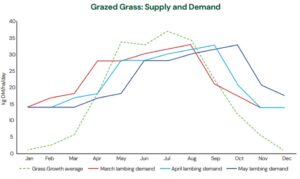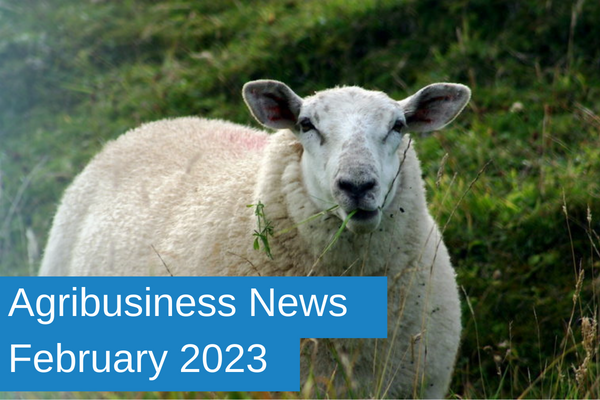Agribusiness News February 2023 – Sector Focus: Ewe Concentrates
2 February 2023Rising cost of concentrate feed
The below graph highlights how (dairy) concentrate feed prices have rocketed from under £250/t in Jan 21 to over £360 in Oct 22. Sheep concentrates sitting above this. Going into 2023, many are paying £380/t for ewe concentrates this month.
Cost of production and profit
In part driven by rising feed costs, the cost of production for lamb has increased substantially in recent years. However, with high lamb prices in the last couple of years buffering this cost, many are continuing with their status quo production system.
For demonstration, shown in the table below, I have modelled a typical flock feeding 50kg/ewe of concentrates using QMS financials for upland flocks in 2019 and 2021.In 2019, the flock, rearing at 145%, selling majority of lambs finished, achieved a small net margin of £6/ewe when concentrate prices where £280/t. In 2021, concentrate costs (£304/t) where up £1.20/ewe and other costs up £4/ewe. This, however, coincided with a major increase in lamb prices (+£25/lamb) meaning a strong net margin of £25.80/ewe was achieved.
This table and the following commentary details three scenarios for the flock. Scenario 1, continues with the same production system with costs continuing to rise including concentrates (£380/t) now at £19/ewe (eq. £13/lamb). With lamb prices stable, this still gave a modest but reduced return of £18/ewe provided lamb prices stay high.
This is viable until scenario 2, when lamb value drops back to 2019 prices. Lower lamb prices compounded by high production costs mean that the flock is budgeted to lose £7/ewe on a net margin basis. This demonstrates a production system, typical of many Scottish flocks, that is wholly un-resilient to market forces, reliant on high lamb prices for any chance of profit, in part due to its reliance on purchased feeds for late pregnancy and early lactation ewe feeding.
Pasture for profit
Concentrate feeding has become seen by many as an essential part of sheep production. However, provided there is sufficient quantity of spring grass this can meet all the ewes’ nutritional requirements.
Key to having sufficient quantity of pasture, is to better match spring grass growth with rising nutritional requirements of the ewe. Shown in the example graph below, March lambing is out of sync with grass growth meaning supplementation is required through pregnancy and lactation with heavy reliance on supplementary feed.
April lambing meanwhile matches peak demand of lactation with rising grass growth meaning supplementation is only required in pregnancy. For May lambing, sufficient pasture is available from 6 weeks pre-lambing meaning prior supplement can be met by silage alone as it is only required for early pregnancy when demands are low.
There is of course a shift in feed demand to later in the season with younger lambs. QMS figures for the top third performing flocks for profit, however, show concentrate feeding (down to 12kg/ewe) to be the single biggest cost saving over average flocks with these flocks also achieving superior sales output.
The final scenario, 3, shows if concentrate use can be reduced down to 12kg/ewe, even under increasing costs and low 2019 lamb prices, this can bring the flock back to a positive net margin of £7.44/ewe. Whilst many high input sheep systems have been profitable in the past that doesn’t mean they are necessarily fit for the future in which input costs are so much higher.

daniel.stout@sac.co.uk; 07917 650 361
Sign up to the FAS newsletter
Receive updates on news, events and publications from Scotland’s Farm Advisory Service



